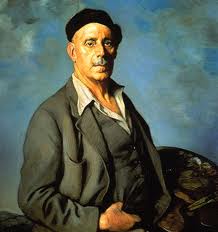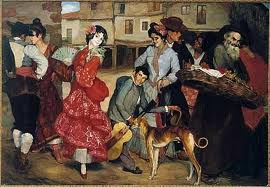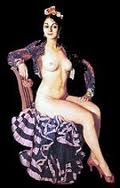Modernism: Ignacio Zuloaga
Ignacio Zuloaga was a Basque Spanish painter who was famous for his depictions of traditional Spanish figures such as gypsies and bullfighters. He is considered to be one of the most important Spanish painters from the end of the 19th Century and beginnings of the 20th Century.
Ignacio Zuloaga (1870-1945)

Ignacio Zuloaga was born in Éibar in the Basque Country in the North of Spain, near the Monastery of Loyola. His family was somewhat artistic as his father, Plácido Zuloaga, was a metalworker and demascener. During his childhood, Zuloaga worked and began sketching in his father's metal workshop. Here he also encountered the art of engraving. However he went to school in France where he was taught by the Jesuits.
Ignacio's father originally wanted his son to become an architect and as a result, he sent his son at the age of nineteen to study the Italian master architects in Italy. However, while in Italy, Zuloaga fell in love with the Italian paintings and decided that he wanted to become a Spanish painter instead. He began painting and within six months he had produced his first painting which was then displayed at the at the Paris Salon in France in the year of 1890.
The success of his painting in Paris led Ignacio Zuloaga to move to the city for five years in order to complete his studies in painting. Here Zuloaga encountered the likes of the French artists Paul Gauguin, the Symbolist painter and Henri de Toulouse-Lautrec. During this time, Ignacio Zuloaga alternated his time between France and Spain, and mostly the city of Segovia.
On his return to Spain, Zuloaga moved to Madrid in order to study Spanish art in the Museo del Prado (Prado Museum). This was the time when Ignacio Zuloaga's style really evolved, particularly from copying the works of Goya, Ribera and Velázquez. His style came to be centred on Spanish National tradition. One of his favourite subjects was traditional Spanish women, complete with fans and flowers. An example of this kind of work is the painting 'Mujer de Alcalá de Guadaira' (Woman from Alcalá de Guadaira).

In 1893 Ignacio Zuloaga went to study in Seville where he would discover the works of the American-British painter James Whistler and also began hanging out more often with French writers who influenced Zuloaga with their Impressionist and Symbolist thoughts.
The following years saw Ignacio Zuloaga presenting some of his works at various exhibitions. In 1894, Zuloaga displayed his paintings 'Retrato de la abuela del pintor' (Portrait of the painter's grandmother) and 'El enano don Pedro' (The Dwarf Don Pedro) at the National Salon of Fine Arts in Paris. He then exhibited his works at Le Barc de Bouteville, the Exhibition of Barcelona and the National Society in Paris. After this, Ignacio Zuloaga returned to Spain to live in Segovia in 1898.
Zuloaga lived with his uncle in Segovia who owned a ceramist workshop. In 1899, Ignacio Zuloaga married his wife, Valentine Dethomas, the sister of one of his best friends, Maxime. Together the pair travelled Europe after their wedding before finally settling in Elgueta, near to Ignacio's hometown of Éibar.
During the 1900s, Zuloaga travelled to the USA and visited Latin America where he began exhibiting his works in various American cities including New York, Boston and Buffalo. In South America he visited Mexico, Chile and Argentina. Following his tour of the Americas, Ignacio Zuloaga returned to Spain in 1920 and went to open a workshop in Madrid.

The latter years of Zuloaga's life were filled with many exhibitions both in Spain and abroad. He died in 1945, in his studio in Madrid and was later burried in the town of San Sebastian. Today his work is displayed in many galleries around the world and he is remembered for the rejuvenation of Spanish National art.
Ignacio Zuloaga also painted many landscape scenes of the harsh Spanish countryside and towns, particularly those with old, ragged houses. For these paintings, Zuloaga often employed Impressionist techniques in order to create these landscapes. However, above all they were a personal interpretation of the scenes, full of expression and energy.
The portraits painted by Zuloaga were often much more concerned with expressing the character of the subject of the painting which often meant that there was little attention to detail or subtleties. He painted numerous portraits including those of Unamuno, Valle-Inclán and Pérez de Ayala.
